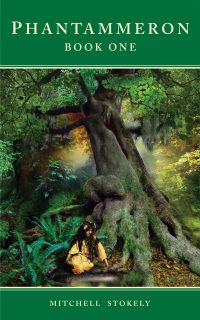Numerous ancient texts have inspired the Phantammeron fantasy novels. One of the main ones was an ancient text from Ireland, the Lebor Gabála Érenn.

In 1989 I stumbled on a copy of this strange translated tale in the old West Stacks of the Southern Methodist DeGolyer Library. I had been seeking a number of books that the author J.R.R. Tolkien might have read that inspired his Silmarillion, though I had yet read that he found inspiration in any ancient Irish material. Tolkien very much looked east towards Europe for most of his material. Instead, in seeking Irish and Celtic lore, I had found numerous old references from poets and novelists of the 19th century pointing to the Lebor Gabála Érenn as a definitive relic of true Celtic writing and myth. And so, I sought to discover as a new fantasy author with fresh eyes what treasures of mythology might lie hidden there.
It’s a very exhausting book filled with pseudo-history, church doctrine, fairy tales, and myth. It covers a classical, Roman origin-myth for ancient Ireland and its people, focusing on the Tuatha de Dannans and ancient fairy people and warriors of the past. Over the course of my readings, my interest in the book would become more narrowly focused on the stories of these ‘Other World’ fairy people and their bizarre and exaggerated battles for dominance, mistresses, treasure, territory, and control of Ireland.
But I found in between these struggles hidden relics of Fairy very close to what inspired Tolkien’s vision of a mystical Other World across the seas, where angelic beings yet reigned; beings pure of heart and spirit still bound to the earth and seas like ancient Man; other-worldly sentient races of light skinned Faerie folk that seemed to represent to the ancient Irish some supernatural Human brings long ago lost and defeated, relegated to some tragic spirit-world now lost to time.
That idea – of there being yet some mystery to Faerie representing a far away mystical misty realm beyond Ireland’s shores – was something completely original to Ireland. European and English folklore seemed to see Faerie in the landscape, in some alternate universe inside our own. But the Irish looked to the western seas, it grand watery majesty haunting them and its calling holding some secret grip over the Irish imagination and this land of their forgotten Faeries.
In this text they described these other races as something beyond this world, not necessarily beside or of it. And that idea felt very Tolkien. But reading these strange histories in this nearly 1000 year old tome that is the Lebor Gabála Érenn inspired me with a fresh vision I needed for my own interpretation of Faerie. And so in the Phantammeron Book One I envisioned Phantaia, the Forest of Twilight, as a “mystical heaven”, a pure and pristine yet endless landscape bound to the Primal Laws of Nature, beholden to a misty realm beyond sea or shore or in sight of any ship, a distant place that would become my idea for the Heaven of the Faerie, their Creation Myth, and the origin of the Gods that would birth their ancestors in later books and worlds yet written.
That essentially is what Book One became for me. Phantaia and the Gardens of Abrea was their ‘Garden of Eden’, a tragic tale of its birth and death, of the birth of their ancient mother Ana and their spirit-tree father Ama; strange Gods that came but from the Sea and the One Tree to form a union of sea and land, and begin the long sad tale of their long history in later books.
Obviously, I have not talked about the Fay or Faerie in Book One. But I wanted to show you that the books have inspiration from very ancient Celtic Myth, and the inspiration comes truly from old visions of Celtic Other Worlds and ideas of Fairyland that predate our own civilization. I wanted to build into Phantaia and the Phantammeron an “Ode to Nature” and of natural-selfhood; of Mankind being born of the woods and oceans, and so like Faerie return that Celtic and Irish concepts back to the very beginning of what it and we once were. I wanted to capture old-faerie in a bottle in my writing and give its sweet, true essence back to the reader in its purest form.
And so using the Lebor Gabála Érenn it was my hope that my stories would transform into a new, more mysterious story about ourselves as Children of Nature, yet something beyond ourselves and this modern time to a place in time when we were like the Faerie, free to live beside primeval Nature again in its purest form, and to dream and to wonder and to believe in what lay beyond our own mortal shores yet hidden still in the imagination.
I took those ideas from the Lebor Gabála Érenn. It’s an amazing tome and I hope you too will discover it wonders and find inspiration.
– the Author



